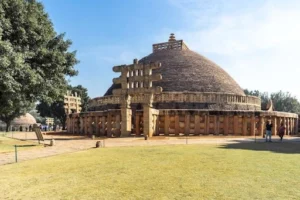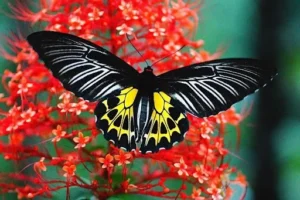UPSC GS 1
The Great Stupa of Sanchi
- News: External Affairs Minister S Jaishankar recently stopped by the replica of the East Gate of Sanchi’s Great Stupa standing in front of Humboldt Forum museum in Berlin.
- The Great Stupa of Sanchi:
- What is a Stupa? A stupa is a Buddhist commemorative monument, typically containing sacred relics of the Buddha or other venerable saints.
- Discovery:
-
- The Sanchi complex was “discovered” by British officer Henry Taylor in 1818.
- Alexander Cunningham, who later founded the ASI, led the first formal survey and excavations at Sanchi in 1851.
- The site was restored to its present condition by ASI director-general John Marshall in the 1910s with funding from the begums of nearby Bhopal.
-

- When was it built: The Great Stupa was commissioned in the third century BCE by Emperor Ashoka, making it the largest and oldest structure in a complex of Buddhist monuments.
- Location: Located 46 km north-east of Bhopal.
- Relics and Patronage: Built over the Buddha’s relics, the construction was overseen by Ashoka’s wife, Devi, from the nearby town of Vidisha.
- Architectural Style: Archetypal stupa is a hemispherical structure.
- Gateways (Toranas):
-
- The Great Stupa is characterized by its ornamental gateways or toranas, oriented to the four cardinal directions.
- These were constructed during the first century BCE under the Satavahana dynasty.
- Each torana consists of two square pillars supporting three curved architraves (or beams).
- These are adorned with bas-relief sculptures depicting scenes from the Buddha’s life, Jataka tales, and Buddhist iconography.
- True to the norms of the period, the Buddha is not represented in human form on these gates.
- Both the toranas and the surrounding balustrade were once painted.
-
- The East Gate and its Replica:
-
- In Europe, the East Gate is the most famous of the Sanchi toranas.
- The East Gate was cast in plaster by Lieutenant Henry Hardy Cole for the Victoria and Albert Museum in the late 1860s.
- Later, Alexander Cunningham led the first formal survey and excavations in 1851.
- The upper architrave depicts the seven Manushi Buddhas (previous Buddhas before the historical Buddha).
- The middle architrave represents the Great Departure when prince Siddhartha left Kapilavastu in search of enlightenment.
- The lower architrave illustrates Emperor Ashoka visiting the Bodhi tree, where Buddha attained enlightenment.
- The gates feature decorative motifs such as the shalabhanjika (a fertility symbol represented by a yakshi), elephants, winged lions, and peacocks. These elements enhance the symbolic richness of the Great Stupa.
-
Read also: Right to Disconnect: A Digital Detox for a Healthier Life | UPSC
UPSC GS 2
Gram Nyayalayas
- News: The Supreme Court recently emphasized that the establishment of Gram Nyayalayas across India would enhance access to justice, particularly in rural areas.
- About Gram Nyayalayas:
-
- Gram Nyayalayas, or village courts, were created under the Gram Nyayalayas Act, 2008, to provide rural populations with swift and affordable access to justice.
- The Act applies to all of India except Nagaland, Arunachal Pradesh, Sikkim, and tribal areas specified under the Sixth Schedule of the Indian Constitution.
- Gram Nyayalayas aim to offer low-cost justice at the doorstep of rural communities.
-
- Constitution:
-
- State governments are empowered to establish one or more Gram Nyayalayas in consultation with the respective High Courts.
- These courts can be set up at the Panchayat at the intermediate level or a group of nearby Panchayats.
- While the Act encourages setting up Gram Nyayalayas, it does not make it mandatory.
- Under Section 4 of the Act, the headquarters of a Gram Nyayalaya may be located in the Panchayat or elsewhere, as notified by the state government.
-
- Presiding Officer:
-
- Each Gram Nyayalaya is headed by a Nyayadhikari, appointed by the State Government in consultation with the High Court.
- The Nyayadhikari has the same powers and enjoys the same salary and benefits as a Judicial Magistrate of First Class.
- Gram Nyayalayas also function as mobile courts, with the Nyayadhikari traveling to villages to hear cases and deliver judgments.
-
- Territorial Jurisdiction:
-
- The territorial jurisdiction of Gram Nyayalayas can be modified by the state government based on requirements.
- These courts handle both criminal and civil cases, as specified in the First and Second Schedules of the Act.
- In criminal cases, they follow a summary procedure.
-
- Conciliation and Natural Justice:
-
- Gram Nyayalayas aim to resolve disputes through conciliation whenever possible.
- Conciliators, appointed for this purpose, help bring parties to an agreement.
- Unlike traditional courts, Gram Nyayalayas are not bound by formal rules of evidence under the Bharatiya Sakshya Adhiniyam, 2023. Instead, they follow principles of natural justice, subject to the rules set by the High Court.
-
- Appeals:
-
- Criminal matters: Appeals against a Gram Nyayalaya’s decision in criminal cases can be filed in the Sessions Court of the respective jurisdiction.
- Civil matters: Appeals related to civil cases can be made in the District Court of the concerned area.
-
National Florence Nightingale Awards 2024
- News: The President of India recently presented the National Florence Nightingale Awards for the year 2024.
- National Florence Nightingale Award:
-
- Established by the Ministry of Health and Family Welfare, Government of India, in 1973.
- The award is given to outstanding nursing personnel working in Central, State/UT governments, and voluntary organizations.
- It recognizes the meritorious services provided by nurses and nursing professionals to society.
- Nurses working in hospitals, community settings, education, or administrative roles are eligible for the award.
- Each recipient receives a Certificate of Merit, a Cash Award of Rs. 1,00,000, and a medal.
-
- Who is Florence Nightingale?
-
- Florence Nightingale was an English social reformer, statistician, and founder of modern nursing.
- She gained recognition for managing and training nurses during the Crimean War, where she organized care for wounded soldiers in Constantinople.
- Nightingale’s efforts to formalize nursing education led her to establish the Nightingale School of Nursing at St. Thomas’ Hospital in London, the first scientifically based nursing school.
-
Trade Connect e-Platform
- News: Recently, the Union Minister for Commerce and Industry launched the Trade Connect e-Platform.
- Trade Connect e-Platform:
- Objective: A digital initiative designed to enhance international trade for Indian exporters, particularly MSMEs (Medium, Small, and Medium Enterprises).
- Functionality:
-
- Connects Indian exporters, MSMEs, and entrepreneurs with various stakeholders such as Indian Missions Abroad, Export Promotion Councils, and other Partner Government Agencies.
- Provides information on global trade events, benefits from India’s Free Trade Agreements (FTAs), and other international trade-related data.
-
- Development: Created in collaboration with the Ministry of MSME, EXIM Bank, Department of Financial Services (DFS), and the Ministry of External Affairs (MEA).
- Significance:
-
- Government Vision: Supports the broader vision of promoting a Digital India, enhancing transparency, and empowering businesses with access to critical trade information.
- Impact: Aims to reduce costs, lead times, and complexities in global trade, helping Indian businesses succeed in the international market.
-
UPSC GS 3
Mithun
- News: Recently, the Chief Minister of Assam announced that the Mithun, a rare bovine species, has been spotted in Assam for the first time.
- About Mithun:
-
- The Mithun, also known as the gayal (Bos frontalis), is a heavily built, semi-domesticated bovine species.
- Believed to have originated over 8,000 years ago, it is considered a descendant of the wild Indian gaur (bison).
- Known as the “cattle of the mountain,” Mithuns are an integral part of the culture in the regions where they are found.
-

- Distribution:
-
- The highest concentration of Mithuns is found in the northeastern region of India, particularly in Arunachal Pradesh, which has the largest population.
- Mithuns are also distributed in parts of Southeast Asia, including Bangladesh, Myanmar, and Bhutan.
- They thrive in regions covered with tropical evergreen rainforests.
- Mithun is the state animal of both Arunachal Pradesh and Nagaland.
- The Adi tribe of Arunachal Pradesh celebrates the ‘Soulung’ festival annually to commemorate the arrival of Mithun on Earth.
-
- Physical Features:
-
- Mithuns are somewhat similar in appearance to the gaur but are smaller in size.
- They are large, strong animals weighing between 400-650 kg.
- A key distinguishing feature of Mithuns is their broad, well-developed frontal bone, which gives their face a flat, triangular shape from the front view, with horns emerging from the sides.
- Their horn color varies from whitish-yellow to black.
- Young Mithuns range in color from light to dark brown, with their coats darkening as they age.
- Adult Mithuns are commonly black with white markings, or white with black markings, although pure black and albino variants are also found.
-
- Conservation Status:
-
- IUCN Red List: Vulnerable
- CITES: Appendix I
-
Read also: Very Small Aperture Terminal (VSAT) | UPSC
Southern Birdwing butterfly
- News: India’s second largest butterfly species, Southern Birdwing, has been found on the satellite campus of The American College between Chathirapatti and Kadavur on New Natham Highway in Madurai district.
- Southern Birdwing Butterfly: Also known as the ‘Sahyadri Birdwing,’ it is India’s second-largest butterfly species.
- Distribution: Found primarily in the Western Ghats of South Asia.

- Physical Features:
-
- It has an exceptionally large wingspan, sometimes exceeding that of smaller birds, which gives it the name “birdwing.”
- Males typically have black wings with greenish-blue markings, while females display cream-coloured markings.
-
- State Symbol: It is the state butterfly of Karnataka.
- Conservation Status:
-
- IUCN: Least Concern.
-
- Key Points about Western Ghats:
-
- The Western Ghats are a mountain range covering 160,000 sq km and stretching 1,600 km along the western coast of India.
- They traverse six states: Gujarat, Maharashtra, Goa, Karnataka, Kerala, and Tamil Nadu.
- Designated as a UNESCO World Heritage Site and recognized as one of the world’s 36 biodiversity hotspots.
- The Ghats are home to high mountain forests that moderate the tropical climate and are a prime example of the monsoon system.
-

